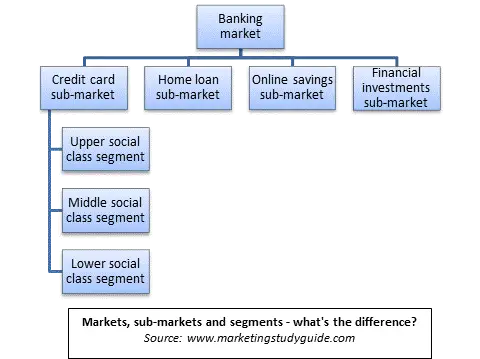When studying marketing it is important to understand the concept of a market and the exchange process.
When we use the term “market” in a marketing sense, there are actually three possible views that we are considering – the overall market, any sub-markets and the brand’s target market/s.
Overall market
The overall market consists of all potential buyers and sellers for a particular product.
As shown here, the overall banking market would consist of individuals, businesses, organizations – as potential consumers – and various providers of banking/financial services as the sellers.
Sub-markets
We can further define a market into sub-markets. Sub-markets are smaller parts of an overall market that are likely to have different competitors, different channels, and different approaches of consumer behavior. In our banking example, we can see that some of the sub-markets would include the credit card market, the mortgage market and so on.
Target markets
A fundamental concept in marketing is the identification and selection of appropriate consumer or business segments to actively pursue. In the above diagram, three potential market segments are shown – but there would be many more possible ways of segmenting these markets.
When a firm selects one or more of these segments (related groups of buyers) in order to develop an appropriate marketing mix, then the segments become the target market for the firm/brand. The firm strategies are then built around the needs of the consumers/businesses within this target market – such as, product range, product design, pricing, channels, in marketing communications (the marketing mix).
The exchange process
The intent of the market situation is to bring buyers and sellers together. In modern-day marketing terms, we call buyers “consumers”. Consumers may be individuals/households or they may be businesses, organizations or even governments.
We would refer to marketing activities targeting individuals or households as B2C – which is business to consumer. And we would refer to the marketing activities targeting businesses as B2B – business-to-business.
The goal of bringing consumers and businesses together is to trigger an exchange process. Essentially, end consumers would generally exchange money/payment for products and services that meet their needs. Without an exchange process, sales do not occur, which is a prime goal of marketing.
Products meet needs or solve problems
Businesses develop products in order to the consumer needs or solve their problems. When we talk about solving problems for consumers we are generally talking about fairly straightforward problems.
Here are some examples…
- A consumer wants to lose weight = low-fat products, fitness centers, personal trainers, diet books – all provide a potential solution to this consumer need.
- A consumer needs a break from work = movies, restaurant, TV, adventure activity, food/restaurant, theme park – again all of these products/services may provide the ideal solution for a consumer in this situation.
Needs versus wants
There is a subtle difference between needs and wants in marketing terms. A need can be described as a consumer problem that MUST be solved – such as being hungry. Whereas a want is an optional approach to solving a consumer need or is a personal goal or desire for the consumer – such as going to a restaurant.
In this example, there are multiple ways that a consumer can solve their need when they are hungry: food at home, quick snack, fast food, beverage, distraction, restaurant, and so on. As you can see, restaurant is only one solution.
Therefore, the underlying NEED that the consumer wants to solve is hunger and the preferred solution at the time is a restaurant. The choice of solving this need through going to a restaurant would be considered a WANT – likewise if the consumer went to a restaurant for a special or social occasion that this would also be considered a WANT.

